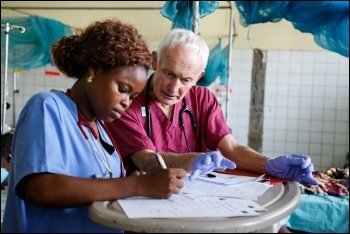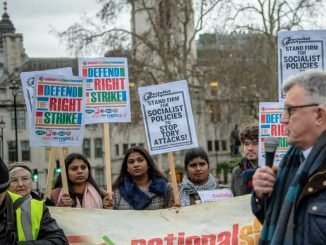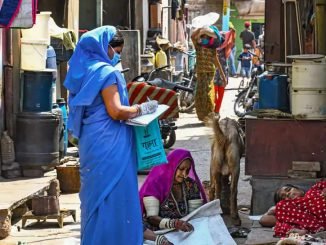
Jim Hensman, (Socialist Party BAME group)
The figures for Covid-19 coronavirus deaths broken down by ethnicity caused widespread shock and anger when they were released on 7 May by the Office for National Statistics (ONS).
After adjusting for age, black men were 4.2 times more likely to die than white men. The equivalent figure for Bangladeshi and Pakistani men was 3.6, and for Indian men 2.4, with similar proportions for women.
Figures for other black, Asian and minority ethnic (BAME) groups paralleled this to different extents.
The first ten doctors to die from the coronavirus were all BAME. The government was forced to promise that Public Health England would provide a report by the end of May.
There has been pressure for an independent inquiry, and the Labour Party has also launched its own investigation.
We may find out more through these investigations. But it is vital for socialists to understand what key factors lie underneath the grim statistics now, to determine how to fight back and rectify them.
The government’s general approach is to divert attention from its failures by peddling the line that it has done the best that was possible – in the circumstances.
The Tories attempt to shift any remaining blame and responsibility onto the individual.
With regard to disproportionate BAME death rates, the government points to supposed genetic factors particularly. This idea was taken up by a University College London epidemiologist, Professor Nishi Chaturvedi. “There’s no evidence that genes explain the excess risk of Covid susceptibility. It’s important to put a nail in that one because it feels as if we can abdicate any responsibility for sorting this out, and this really isn’t the case.”
In the US, attempts to put responsibility on the individual have reached farcical proportions. Jerome Adams, the (black) surgeon general appointed by Donald Trump, stated that to avoid the virus, “African Americans and Latinos should avoid alcohol, drugs and tobacco”!
Inequalities key
But as the pandemic has developed, the key factors that have emerged as responsible for inequalities in death rates are inequalities in society as a whole.
Consider poverty. The government uses a measure called the Index of Multiple Deprivation to help allocate local spending. ONS figures showed that in England and Wales, the most-deprived areas on this index had twice the coronavirus death rate of the least deprived.
Deaths, in general, are not recorded by ethnicity. But the connection can be inferred. Government figures from 2019 found black people were 56% more likely than the national average to be in the ‘persistent low income’ category. Asian people were twice as likely.
Occupation statistics are another indicator. A higher proportion of BAME workers are in ‘low-skilled’ jobs than the average. ONS figures showed men in ‘low-skilled’ jobs were four times more likely to die from the coronavirus than men in professional jobs.
Similarly, they found that women working in ‘low-skilled’ care jobs were twice as likely to die from the coronavirus as those in professional and technical jobs. In London, 67% of the adult social care workforce is BAME.
Overcrowded housing is yet another key risk factor. According to a 2018 government survey, 2% of white British households experienced overcrowding according to their definition. This compared to 15% of black African, 16% of Pakistani, and 30% of Bangladeshi households.
General health is an important consideration too. Existing health problems are significant contributors towards coronavirus fatalities. But the capitalist establishment states this as if it is a given, caused either by bad luck or an individual’s bad ‘lifestyle choices’ – frequently brought up in relation to ethnic minorities.
However, general health too is linked to the inequality of class-based society. In February 2020, a team led by the distinguished academic Michael Marmot published its latest Health Equity in England report. Using life expectancy as a general index of health, Marmot found there had been no improvement in the last decade – something unprecedented in over a hundred years.
The report highlighted the role of austerity in this. Among women in the most-deprived areas, life expectancy had actually fallen! The time people spent suffering poor health had increased since 2010 – directly increasing vulnerability to the coronavirus.
How this particularly affected BAME individuals was highlighted in a report from the British Heart Foundation. “Before the outbreak of Covid-19, BAME populations were already more likely to suffer ill health, including heart and circulatory diseases and their risk factors such as high blood pressure and diabetes, and from a younger age. Much of this is linked to social and economic inequalities rather than genetics.”
Other factors?
But do social inequalities explain all the discrepancy in BAME death rates? The ONS carried out an analysis which tried to measure how social conditions impacted on BAME deaths – so it could adjust the figures to take this into account. It is worth looking at this in detail.
ONS statisticians constructed a model for predicting coronavirus deaths in general. It used factors like location and the deprivation index associated with it, housing and other information, and indications of individual health and disabilities.
What they were effectively asking was: if you were white, but lived in the same area, had the same type of housing, and so on – would you still have died?
They found this reduced the discrepancy in the numbers. For black men and women it was now 1.9 times the white figure, and for Bangladeshi and Pakistani men 1.8 times – so the figure had roughly halved. This is a direct indication that class inequality drives up coronavirus deaths.
But what about the remaining half of the discrepancy that was still unexplained? To get an idea of what might account for this, we need to examine what the statisticians were doing a little more closely.
The government often tries to hide behind the claim that it is “driven by the science”. This is untrue; it is driven by the defence of the profit system, and its own political survival. But even if it was true, science always has to be seen in its context, so in a case like this it is important to dig deeper.
Let’s start with a simple example. Overcrowding is one of the factors the ONS tried to take into account. At any time, this can clearly have a detrimental effect on health. However, with the coronavirus, it takes on another dimension.
Everyone would have been deeply touched by the tragic stories of families in accommodation who share toilet and bathroom facilities with other families. This makes it almost impossible to self-isolate, despite desperate attempts to do so, often with the result that the infection spreads between families.
This situation will particularly be experienced by the poor. So it will be reflected to a higher extent in BAME people, including groups such as asylum seekers and refugees living in hostels and similar accommodation.
The problem is that general indications of overcrowding, which the ONS and others have to rely on, would not reflect the more specific situations that may affect ethnic minorities in cases like these.
Overcrowding can negatively impact on other factors known to influence coronavirus mortality. This includes intergenerational family groups living together – a situation with a higher prevalence among certain ethnic minorities.
And the ONS itself released numbers on 14 May showing that black people in England were nearly four times as likely as white people to have no outdoor space at home. Especially when the weather is warm and sunny, as it has been, people will need to make more use of outdoor spaces.
The ONS actually produced statistics showing average distances people would have to go to do this. But crowded parks can become hotspots for coronavirus transmission. Councils around the country have even closed parks, sometimes counterproductively.
Information like this about the different factors that can individually affect health, but also interact with each other, is clearly relevant. But it is not necessarily measured, and in some cases can be more difficult to quantify or record. Therefore, it may not be taken into account.
There is a technical point relating to this which illustrates how science is not a single objective representation of reality, but rather is influenced by many considerations. The methodology used by the ONS in this study on BAME deaths is called ‘logistic regression’. This method is not intrinsically suited to representing interactions between causative factors in general – which, as we have seen, could be relevant.
Health workers
Deaths among health workers have rightly received a lot of publicity. They can perhaps provide us with the best indication of what is going on, because of the greater detail available.
The figures for BAME deaths are stark. Taking the NHS as a whole, about 21% of staff are BAME. But figures released at the end of April showed that, up to then, they had accounted for 64% of NHS staff deaths from the coronavirus. So the huge discrepancy in society generally is also reflected here.
But how could this be? These were people working for the NHS, not a cross-section of all society. Doctors, for example, could hardly be said to sit at the bottom of the socioeconomic tree.
In mid-May, ITV News released a survey of more than 2,000 NHS staff, and broadcast interviews with a number of them. A key thing this showed was that there were many more BAME staff in frontline roles – with higher exposure to the virus. The reasons appear to be a combination of two factors.
The first factor is that, within each given health role such as doctor or nurse, all staff at lower grades have higher death rates. This is one expression, on a smaller scale, of some of the economic inequalities in class society generally. And within each given role, BAME staff are more likely to be in the lower levels.
According to one health charity, The King’s Fund: “On average, black doctors in the NHS earn £10,000 less and black nurses earn £2,700 less annually than white colleagues. Minority ethnic-group staff are systematically over-represented at lower levels of the NHS grade hierarchy, and under-represented in senior pay bands.”
This helps explain the situation in what would seem to be a relatively privileged group, the doctors. One BAME consultant cardiologist explained it like this in the ITV survey: “Many of the white doctors are in management positions, leaving more BAME at the coalface.”
This differentiation occurs at every level. NHS information shows it is mirrored with junior and senior doctors, and junior and senior manager grades.
The second factor is clearly direct racism and discrimination. Half of the respondents in the ITV survey felt that this played a part in the high death rate, and 20% said they had experienced it personally.
One BAME doctor reported that “suggestions from the BAME group are not taken by hospital management. The concerns or comments are ignored. Not a single BAME member was included in the Covid response team.”
A number of workers, including a Filipino nurse who appeared on the programme, stated they were scared to speak out about concerns like the shortage of PPE, because they feared losing their jobs.
In some cases, visa regulations and other measures made staff even more vulnerable to this.
Both socioeconomic factors and racism are thus responsible for the higher number of BAME deaths. But these causes are not independent. They interact with each other: discrimination is obviously the key factor in BAME workers tending to be among the staff in harder-hit lower grades.
Class and race
What can we conclude overall about BAME death rates? It is possible that much more of the discrepancy between white and BAME deaths is based on class inequalities than officially estimated. But racism is nevertheless also a very important factor.
Although it’s not ruled out that other factors may play some subsidiary role, class inequality and racism are undoubtedly the main problems. The key question is: how can they be addressed?
The struggle against racism and institutionalised racism must be a priority. BAME workers will need to play a central part in this. But racism cannot be separated from issues of class inequality.
The struggles against each must be combined. Inadequate PPE, for example, may impact on BAME workers to a higher extent – but it still affects all frontline workers, and must be fought against as part of a general struggle by all workers.
There are many ways to fight, but crucial will be trade union and political action. If existing workers’ institutions in these fields do not prove adequate for the task, they must be transformed or replaced.
The workers’ movement must also be careful not to be diverted into playing off one section against another. BAME workers are particularly affected in many areas, but not alone, and not necessarily in all areas.
For instance, 95% of care home residents are white. But obviously, a campaign against the care home deaths scandal is not just a ‘white issue’.
The traditional motto of the workers’ movement – an injury to one is an injury to all – must be central to all struggles.
There are lessons from a previous disaster. On 14 June 2017, a fire broke out in Grenfell Tower in west London. Over 75% of those who died had a BAME background. This was definitely a BAME issue.
So how could the campaign make sure this atrocity is not repeated? Undoubtedly, BAME workers are disproportionately residents of similar, unsafe working-class accommodation. But the only guarantee would be eliminating unsafe housing in the population as a whole.
In one sense, we can consider the Covid-19 death toll, at its peak in Britain, equivalent to 15 Grenfell Towers a day.
There are more lessons from Grenfell. One is on public inquiries. These can be used by campaigns to apply pressure and get information, so they shouldn’t be disregarded.
But the abject failure of the Grenfell inquiry, nearly three years after the fire, is a warning not to place too much reliance on anything similar with regard to coronavirus deaths.
Neither, if something is a BAME issue, can we rely on BAME politicians for support simply by dint of their being BAME. We only need to consider Priti Patel and Rishi Sunak.
The failure of a strategy which looks to individual racial representation rather than class politics is underlined by the tragic situation in the US today. Many of the worst-affected cities with large black populations have had black mayors – as well, of course, as the country having had a black president.
The excessive rate of coronavirus BAME deaths is important and highlights several aspects of what is wrong with society under capitalism.
What is required is taking up the fight against this scandal as part of the wider class struggle, and linking it to the fight for a socialist society that will eliminate the inequalities and irrationalities of the current economic and social system.
This version of this article was first posted on the Socialist Party website on 22 May 2020 and may vary slightly from the version subsequently printed in The Socialist.
Donate to the Socialist Party
Coronavirus crisis – Finance appeal
The coronavirus crisis has laid bare the class character of society in numerous ways. It is making clear to many that it is the working class that keeps society running, not the CEOs of major corporations.
The results of austerity have been graphically demonstrated as public services strain to cope with the crisis.
The government has now ripped up its ‘austerity’ mantra and turned to policies that not long ago were denounced as socialist. But after the corona crisis, it will try to make the working class pay for it, by trying to claw back what has been given.
- The Socialist Party’s material is more vital than ever, so we can continue to report from workers who are fighting for better health and safety measures, against layoffs, for adequate staffing levels, etc.
- Our ‘fighting coronavirus workers’ charter‘, outlines a programme to combat the virus and protect workers’ living conditions.
- When the health crisis subsides, we must be ready for the stormy events ahead and the need to arm workers’ movements with a socialist programme – one which puts the health and needs of humanity before the profits of a few.



